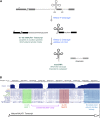An unexpected ending: noncanonical 3' end processing mechanisms
- PMID: 20007330
- PMCID: PMC2811654
- DOI: 10.1261/rna.1907510
An unexpected ending: noncanonical 3' end processing mechanisms
Abstract
Proper 3' end processing of a nascent transcript is critical for the functionality of the mature RNA. Although it has long been thought that virtually all long RNA polymerase II transcripts terminate in a poly(A) tail that is generated by endonucleolytic cleavage followed by polyadenylation, noncanonical 3' end processing mechanisms have recently been identified at several gene loci. Unexpectedly, enzymes with well-characterized roles in other RNA processing events, such as tRNA biogenesis and pre-mRNA splicing, cleave these nascent transcripts to generate their mature 3' ends despite the presence of nearby polyadenylation signals. In fact, the presence of multiple potential 3' end cleavage sites is the norm at many human genes, and recent work suggests that the choice among sites is regulated during development and in response to cellular cues. It is, therefore, becoming increasing clear that the selection of a proper 3' end cleavage site represents an important step in the regulation of gene expression and that the mature 3' ends of RNA polymerase II transcripts can be generated via multiple mechanisms.
Figures


References
-
- Baillat D, Hakimi MA, Näär AM, Shilatifard A, Cooch N, Shiekhattar R. Integrator, a multiprotein mediator of small nuclear RNA processing, associates with the C-terminal repeat of RNA polymerase II. Cell. 2005;123:265–276. - PubMed
-
- Bentley DL. Rules of engagement: Co-transcriptional recruitment of pre-mRNA processing factors. Curr Opin Cell Biol. 2005;17:251–256. - PubMed
-
- Blackburn EH. Telomeres and telomerase: Their mechanisms of action and the effects of altering their functions. FEBS Lett. 2005;579:859–862. - PubMed
Publication types
MeSH terms
Substances
Grants and funding
LinkOut - more resources
Full Text Sources
Other Literature Sources
Molecular Biology Databases
